Easton baseball equipment manufacturer is among some of the oldest sporting companies. Easton Diamond Sports, LLC produces significant baseball bats and other baseball equipment. However, as a baseball fan, you may be familiar with Easton baseball equipment, especially the baseball bats.
The Easton bat company headquarters is in Van Nuys, California, America. Doug Easton started the Easton company in 1922. However, Easton Diamond Sports, LLC is currently headquartered in Thousand Oaks, California.
Easton has been making top-quality baseball equipment from the beginning of its involvement in baseball equipment making. Easton was the first company that implements aluminum in baseball bats.
But, do you know, Easton starts as a bow and arrow-making company? Interesting, isn’t it? There are a lot of facts to know about the Easton baseball equipment manufacturer. The exploration of history would be helpful to learn more about the Easton baseball equipment manufacturer.
The History Begins
Every successful company has a starting point. Easton, on the other hand, also starts from somewhere. The start has been sustained for 100 years in this year. Sustaining 100 years is a milestone for any company. Thanks to Easton Sporting manufacturing company for their quality equipment.
By the way, Easton company was formed by following the footsteps of Doug Easton. He established it as an Archery equipment manufacturing company. It happened because Doug Easton, the founder of Easton, was an archery enthusiast.
1922: Doug Easton Starts The Company
Doug Easton had become an archery enthusiast at his 15. It happened coincidently because of a unique environment.
In the last of the year 1921, Doug was hunting near his home in Watsonville, California. An accident happened with his shotgun. That was a collision with a car. His shotgun fired for the consequence of the clash with the car.
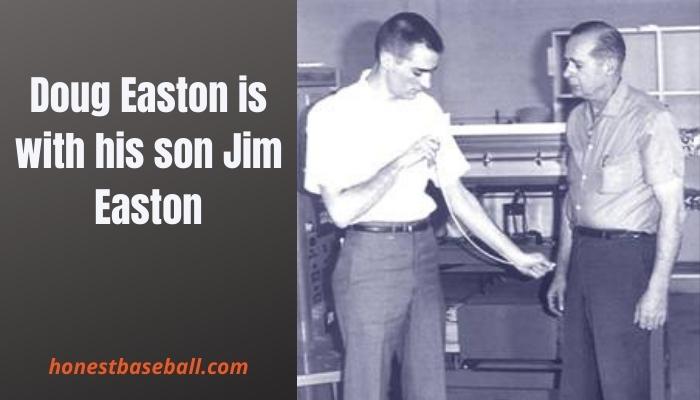
The accident injured both his legs and sent him to hospital. Until the following year, he was confined at the hospital and his home for most of the time.
By this time, one of his friends had given him a book. The book was on hunting, named “Hunting with the Bow & Arrow.” Dr. Saxton T. Pope is the writer of the book. The book made Easton fascinated with hunting with bow and arrow.
After a bit of recovery, he started crafting bows and arrows from wood. He had been starting to use cedar and pine wood for his crafting.
Coincidently, he met Mr. Saxton T. Pope in San Fransico when he was shooting his archery in a tournament at his 17. He did not know that the older man was Mr. Saxton. When the man complimented his craftsmanship and shook hands with him he came to know that.
However, Doug started to craft bows and arrows on a part-time basis. And he continued that for the next ten years. In 1932, he decided to switch his career to archery craftsmanship entirely. He moved to Los Angeles and opened “Easton’s Archery Shop” by taking the decision.
Easton Archery Starts
However, after opening his archery shop in Los Angeles, Doug befriended some elite citizens of Hollywood. With whom he shared his archery enthusiasm. By this time, Doug started to design broadheads arrows. From 1938, he began to use aluminum in the broadheads.
When he maintained larger facilities in Los Angeles, he started to experiment with aluminum shafts for the arrows in 1939. Because he faced some inconveniences with the wooden arrows.
However, he presented his first-made aluminum shafted arrow to Larry Hughes. Larry was a local archery champion. Larry was satisfied with aluminum arrows and participated in the archery championship in 1941’s national championship.
However, World War II had already begun at that point. Consequently, The United States military confiscated all-aluminum supplies destined for civilian use. Because of this, Doug was unable to take advantage of aluminum arrows via Larry Hughes at the time of the incident.
After the next year of finishing WW2, aluminum was finally available again. By this time, Doug had brought his first trademarked aluminum arrow, which was named “24SRT-X.”
By 1949, Doug stopped making finished aluminum arrows, emphasizing aluminum shafts. However, in 1953, he renamed his business “Jas. D. Easton Archery”. But you know, till this was a one-person shop.
The “24SRT-X” was a big success, and in 1956, he employed two full-timers for his business. In 1957, he relocated his company to Van Nuys, running a 10,000-square-foot facility. He created history during the following decade by inventing the “XX75” arrow shaft. This is the world’s most popular and best-selling arrow shaft.
1960: James Easton Joins The Company
Doug Easton tried to bring his son James to the company before hiring the full-timers. He also insisted James quit his study. But, James refused and continued his study.
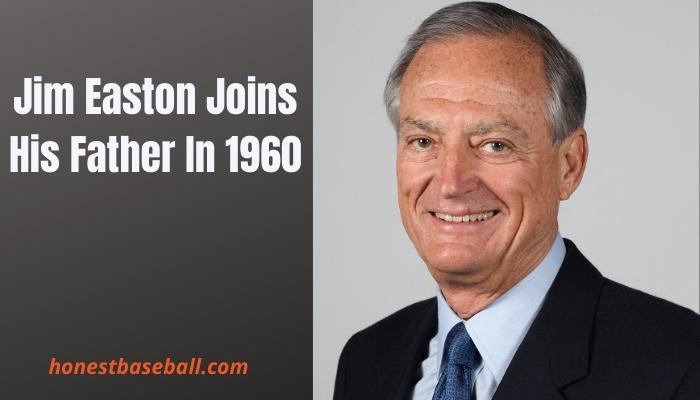
James joined an aircraft company and left the job in 1960. Jim Easton then joined his father in Easton Archery. Doug Easton focused only on the archery business, but Jim Easton pushed his father to expand the business area.
Because of Jim’s pushing, the Easton company started to expand its business. In 1964, the company first introduced aluminum “Ski-Pole Shaft” which was the first non-archery product of Easton.
In 1967, Easton company went beyond sports and worked in precision tubing development. The precision tubing is used to make a thermal shroud for seismometers. The amazing fact about their precision tubing was used in the Apollo mission to the moon.
On the other hand, Easton got its start in team sports by producing aluminum baseball bats in 1969. However, Easton is not the first company to produce aluminum bats. But, they pioneered a game-changing advancement in the manufacture of aluminum bats. We believe that the baseball bat part of Easton should be discussed in a separate section.
Doug Easton passed away on December 1, 1972, from cancer. Jim Easton took over the company at that point. In 1976, Jim Easton began producing tent tubing. As a result, Easton was hired to make racket frames by PRINCE, a prominent tennis racket manufacturer.
Easton, on the other hand, began designing aluminum hockey sticks in the late 1970s. It was the brainchild of an ex-amateur hockey player who also happened to be an Easton engineer.
As a result, the National Hockey League gave Easton permission to manufacture hockey sticks. They introduced the first commercial hockey stick model after a year of approval.
1969: Stepped Into Baseball Bat Industry
Easton entered the baseball bat manufacturing industry in 1969 with its initial model. It was a watershed moment in the history of aluminum baseball bats. Because, when Easton captures the aluminum bat manufacturing business, aluminum baseball bats were just adequate in terms of strength.
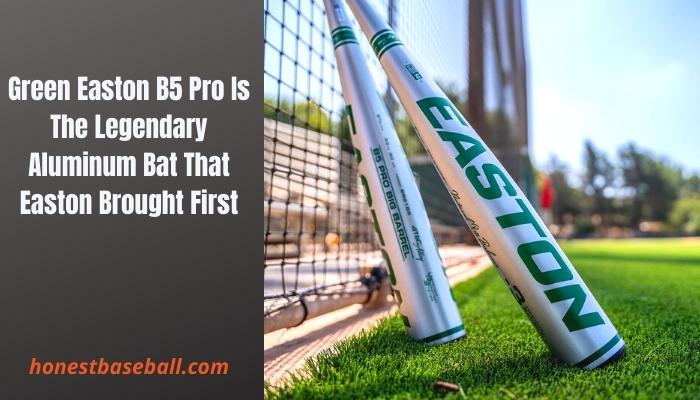
However, they had not provided a significant improvement in performance over wooden bats. Aluminum baseball bats were unbalanced, hefty in weight. They also did not provide extensive hitting progress than wooden baseball bats.
The sole benefit was that aluminum bats were very durable and did not shatter. Easton, on the other hand, was responsible for substantial advancement in aluminum baseball bats. They attempted to resolve the challenges that aluminum bats were experiencing.
Easton was able to achieve remarkable success with aluminum baseball bats. It was possible because of going through extensive engineering and development procedures.
They were able to manufacture thinner-wall aluminum baseball bats. Yet maintaining their curved design.
Doug Easton, the company’s creator, had passed away in 1972 by this time, though. Easton has been operating under the auspices of a privately held corporation. The event was happening from the beginning of the baseball bat manufacturing of Easton. This means that the bat manufacturer, Easton, was unable to mark their product with their name.
“In order to establish the brand recognition, Jim Easton requested the firm to include their name on the bats. This is so that people would identify the Easton company. However, the plan was turned down by the firm.
Consequently, in the mid-1970s, Jim Easton decided to remove Easton from the corporation. And wanted to start his own line of baseball bats under the name Easton.”
Since then, Easton has built a reputation for producing high-quality bats. Also, it established itself as a leader in the baseball bat market.
Further Advancement From The 1980s To 1990s
In the time of 1980s, there are a bunch of successes came to the Easton company. Easton acquired Hoyt Archery Company in 1983. This company makes high-end archery bows.
In 1985, Easton purchased Curley-Bates. This is an aluminum baseball bat distributor. After acquiring the company, Easton named this as “Easton Sports Inc.”
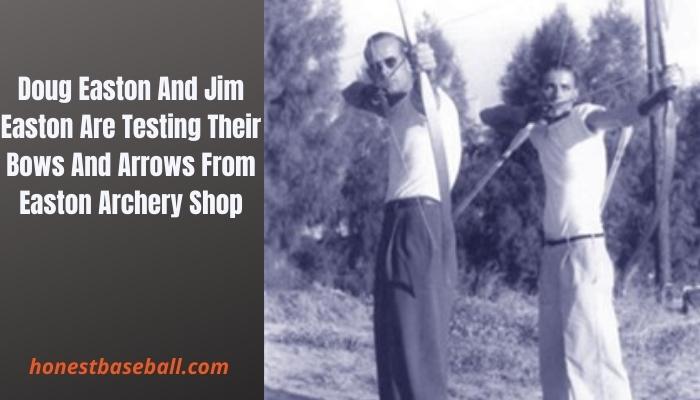
Jim Easton, on the other hand, had ambitions for the firm that went beyond the manufacture of baseball bats. He intended to use the firm to create top-of-the-line team sports apparel. With the thinking, Jim implemented the strategy. As a result, Easton corporation began to establish a position on the worldwide market.
At the end of 1987, Easton Sports established an automated warehouse in Salt Lake City. The warehouse is still in operation today. The idea was to distribute the items for the foreseeable future. This would also be supporting the brand.
“Easton Sports Canada” was established in 1986. It was established as a sports division of the Easton corporation. This was for making sailboard mast and boom tubing. The firm also manufactured bicycle frame tubing.
Easton started to produce its own cycles. But, it halted the segment because of expenses in 1990. However, the most profiting business of Easton was the Easton baseball and Easton softball bats lineup.
Easton, on the other hand, debuted their composite-based golf shaft in 1990. It established its own sports research center in the same year to continue developing sports equipment.
“In 1987, Easton had a market capitalization of $90 million, up from $13 million in 1977. In 1991, they even broke the $100 revenue barrier. In the 1990s, Easton controlled the aluminum arrow industry with an 80% market share.
Even in the Olympic games, from 1972 until 1992, every gold medalist in archery used Easton aluminum arrows.”
The 1990s: A New Era Starts
Easton had been emphasized on aluminum hockey sticks at a time. But the development was slow anyhow. However, Easton started to establish itself in hockey in the 1980s. It is because when Brett Hull started to use Easton aluminum hockey sticks on the ice.
But, it got more emphasized in 1990, due to the hockey superstar Wayne Gretzky. He visited Easton to try out its hockey sticks. He liked them so much that he agreed to $2 million endorsements for the next seven years.
In 1991, Jim Easton said to California Business,
“Our strategy is to have a performance product first, to break in the sport and get a reputation. And once you’ve got that, then you can bring out other good quality products. Otherwise, you’re in a commodity business, and you’re just trying to sell by price.”
By 1994, however, the number of Easton hockey product users had increased to 150. They’re all from the National Hockey league.
Easton had already released their Ultra-Light composite hockey sticks. Also, the X-Treme Graphite blade at this point. Easton created lighter-than-wooden hockey sticks. Based on the players’ demands and ideas, they created a lighter version of the sticks.
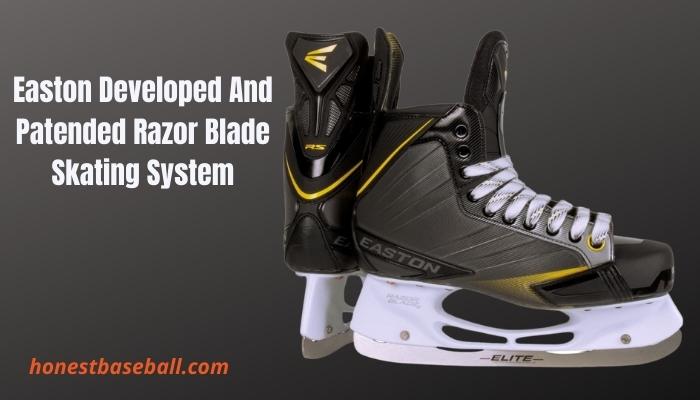
It’s incredible to think that over 40% of NHL players were using Easton hockey sticks by the year 2000. It outperformed all other hockey sticks.
At the end of the 1990s, Easton introduced “Parabolic Blade Technology.” It is their signature segment for ice skates. They patented the “Razor Blade Skating System.” It transfers energy from the foot of the runner to his blade. It allows 25% tighter turn and glide.
Development In Baseball And Softball Bats
Hockey was Easton’s priority though, its aluminum bats for baseball and softball remained on top. Unfortunately, extensive quality and extreme development brought a consequence in the early 1990s.
“Easton developed a titanium softball bat performed extreme. Due to this reason, the softball association banned it. The logic behind the ban was that the association mentioned, it was too good. Its extreme performance provided extra performance. And this goes extreme against the opposition team.”
However, this ban could not push Easton back too much. Easton continued its bat design and got succeeded. In 1997, Easton brought its first Redline series, the first Scandium bat in the market.
Easton introduced the first two-piece baseball bat technology in 1999. The ConnecXion series was the one in question. The introduction of two-piece bats resulted in considerable improvements. Which impacted both performance and physical structure.

Two-piece bats have less vibration and a bigger sweet spot than single-piece bats. Easton, on the other hand, has continued to manufacture wooden bats in addition to metal bats throughout this period. In 1999, Easton bought Stix Baseball Inc., a baseball bat manufacturer. It was a wooden bat company with headquarters in Orlando, Florida.
By producing excellent baseball and softball equipment, Easton has made a big contribution to the industry. This is where they do their research and development. The peak attempts were placed in the research section by Easton’s engineers.
They assure a trademarked research outcome and execute aluminum advancement in athletic equipment. That includes baseball and softball bats.
Easton, on the other hand, has been able to establish long-term relationships in a variety of baseball leagues. World Series, NCAA Collegiate Teams, and Professional Sports Organizations are among them.
Domination In Bat Manufacturing
The aluminum bats got their first approval in the 1970s. This facilitated a significant opportunity for aluminum bat manufacturing for Easton. Because there were aluminum bats, but not that developed.
Easton engineers re-engineered the aluminum bats. Significant engineering brought the Green Easton B5 Pro to the market. It was a 71/78 aluminum alloy bat with a diameter of 2⅝ inches barrel. This was a game-changer in the market by that time.
During the 1980s and 1990s, Easton, on the other hand, dominated the college baseball scene. Since aluminum into the bats, Easton aluminum alloy bats have been the most popular bats in college league baseball.
The first entirely composite carbon bat was developed by Easton in 2003 for the Slowpitch softball. This was implemented after the development of the first 2-piece bat. Consequently, a fastpitch version of the bat was produced in 2004.
On the other hand, Easton was the first company to introduce the rotating handle for baseball bats, which was introduced in 2014.
However, Easton Beast Pro Drop 5 is one of the best bats of Easton. You may find the review article helpful if you are looking for a one-piece Easton.
Easton allows you to take away the pitcher’s pitches.
Notable Years For Easton Sporting
- 1922: Douglas Easton begins to make bows and arrows.
- 1932: Doug Easton moved to Loss Angeles and established Easton Archery Shop.
- 1938: Doug Easton started to design aluminum broadheads.
- 1939: Doug Easton started to make aluminum arrow shafts.
- 1946: Doug had brought his first trademarked aluminum arrow, which was named “24SRT-X.”
- 1953: Renamed the company as Jas. D. Easton Archery.
- 1960: Jim Easton joined his father.
- 1964: Brought ski-pole shaft, which was the first non-archery product.
- 1969: Stepped into the baseball bat manufacturing industry and developed aluminum baseball bats.
- 1972: Doug Easton died and Jim Easton took over the company.
- 1976: Easton began to produce tent tubing.
- 1983: Easton acquired Hoyt Archery Company.
- 1985: Easton bought Curley-Bates and named it Easton Sports Inc.
- 1986: Easton Sports Canada was formed.
- 1990: Hockey superstar Wayne Gretzky endorsed $2 million for the next seven years in Easton.
- 1997: Designed the first Redline series of the baseball bat.
- 1999: Introduced the first-ever 2-piece baseball bat.
- 2014: Introduced first rotating handle for the baseball bat.
- 2020: Easton Diamond Sports LLC., was acquired by Rawling Sports Goods.
Baseball And Softball Products
The Easton company was not established for producing baseball products. But it became among the top manufacturers of baseball products in a short time. Easton makes baseball and softball bats, Easton baseball gloves, helmets, catcher’s gear. They also manufacture Easton baseball bags, apparel, accessories, etc.
However, Easton bats are categorized in different segments. They include baseball, softball, and slowpitch softball bats. However, there are also many bat series they manufacture as well.
“Their bat series include Easton Ghost Hype, ADV 360, Maxum, Alpha ALX, B5, etc. Easton’s bats are also certified in different categories. The certification includes BBCOR, USSSA Baseball, USA, USSSA Slowpitch, Senior Softball, etc.”
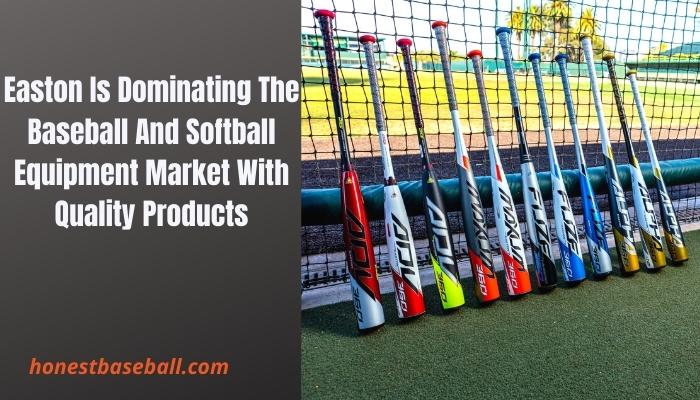
On the other hand, Easton also makes gloves for all positions and ages with different sizes. The gloves’ series includes the Signature series, Professional Collection Kip, Flagship, etc.
Helmets and catcher’s gear are two big segments that Easton brings significant premium. Okay, if you summarize their products in a list, you will find the following products from Easton Diamond Sports, LLC.
- Bats
- Gloves
- Helmets
- Catcher’s Gear
- Bags
- Apparel
- And other baseball and softball accessories.
Easton has two great bats which are Easton S3 and Easton Mako. How do these two perform and are comparable? This comparison between Easton S3 Vs MAKO will help you to understand the facts.
Easton baseball equipment manufacturer: Change Of Ownership
When the Easton firm was established in 1922, it was primarily focused on the production of archery equipment. Doug Easton started it part-time and has been working on it ever since.
Things changed after Easton joined the baseball equipment manufacturing business in the 1960s. Doug Easton’s son, Jim Easton, continued the family business following his father’s death. He was expanding it into hockey and cycling as well.
In year 2006, Easton had ever first acquired by any company. Jim Easton sold the company to Fenway Partners for $400 million. But, they could not bring success in the baseball and softball sectors.
As a result, in 2014, Bauer Performance Sports Ltd. bought Easton Sporting’s baseball and softball business for $330 million. However, they brought the Easton to number 1 position in the baseball and softball equipment category. They were able to capture 30% of the baseball and softball equipment market share.
On the other hand, in October 2020, Rawling Sports and Easton Diamond Sports LLC., came to an agreement to merge. After this agreement, Rawling announced that they were going to acquire the Easton baseball equipment manufacturer.
Let’s check the year-wise short infographic of Easton Diamond from the beginning.
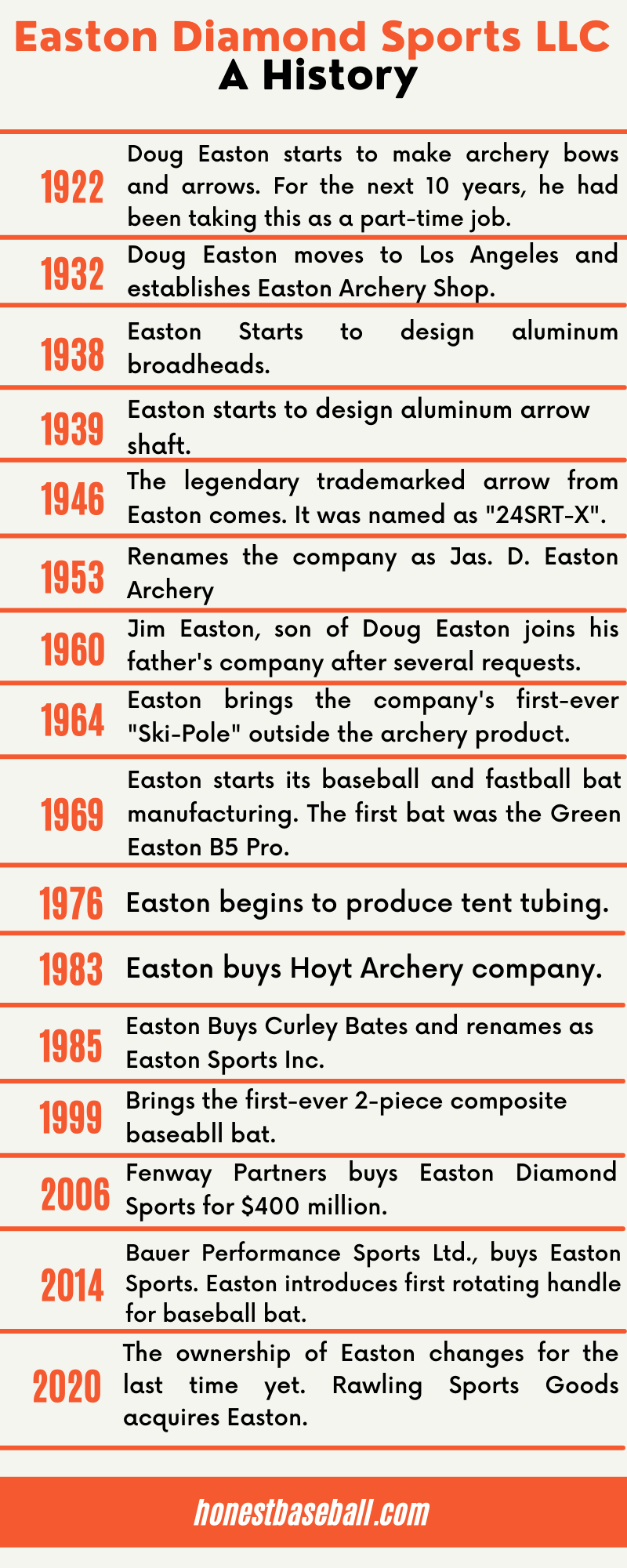
Currently, Easton is under the ownership of Rawling Sporting Goods.
Frequently Asked Questions
- Who Bought Easton Diamond Sports LLC.?
Rawling Sporting Goods, a leading baseball and softball equipment manufacturing company, acquired Easton Diamond Sports in 2020. Rawling merged the Easton with them to ensure the best baseball and softball equipment.
- Where Are Easton Products Made?
Easton was established in Van Nuys, California as an archery products manufacturer. However, they are currently one of the leading baseball and softball equipment manufacturers. They are headquartered in Thousand Oaks, California. Easton manufactures its baseball and softball equipment there.
- Is Eaton A USA Company?
Doug Easton established Easton in 1922 in California. It was entirely an American-based company as Doug Easton was an American.
Conclusion
From the beginning of Easton Archery, Doug Easton produced outstanding archery products, such as bows and arrows. When his son Jim joined him in 1960, he pushed his father to expand.
In 1969, Easton entered into baseball and softball bat manufacturing industry. They brought the most significant revolution in the aluminum bat industry. Even after adopting the technology, Easton dominated the aluminum bat market.
However, Easton baseball equipment manufacturer has been producing baseball and softball equipment since the 21st century. Though different companies have acquired them, they never have down the investment of their parent company. Currently, Rowling Sporting Goods has been the Easton Sporting Diamond LLC owner.

Hello everyone. My name is Jason Butler, and I live in California, America. I was a professional AAA Minor League Baseball player. I lost my chance of playing MLB for injury issues, but I did not lose my love for baseball. I attended the coaching training program and am now working as a coach in a small school in San Diego.
I always love to share my experience and knowledge if that can help you. Play baseball, and stay fit.
